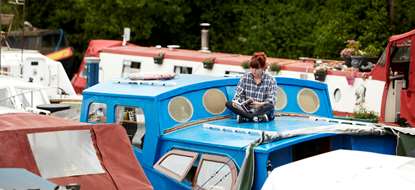Planning a trip to the River Trent? You’ve come to the right place!
On this page, you’ll find our complete boating guide to the River Trent.
Topics in this guide include:
- What to do near the River Trent?
- Where are the best places to moor near the River Trent?
- How long does it take to sail the River Trent?
And much more!
So, let’s get into it:
Where is the River Trent?
The River Trent is England's third-longest river and spans six counties across the Midlands.
Originating in Staffordshire's Stafford Moorlands, it gracefully winds through Derbyshire, Leicestershire, Nottinghamshire, and Lincolnshire before joining the Humber Estuary on the UK’s East coast.
What to Do on a Trip to the River Trent?
There’s a tonne of things to see and do on a trip to the River Trent.
Alongside the peaceful and beautiful countryside, some popular tourist attractions include:
- Attenborough Nature Reserve
- Broadway Cinema
- St Mary’s Church
- City of Caves
- National Justice Museum
- Holme Pierrepont Country Park
Some other great sites and activities include:
- Visiting Gunthorpe
- Taking a walk near the Trent Lock
- Exploring the weir at Beeston
- Strolling near Nottingham Victoria Embankment
- Checking out Newark Castle
- Journeying to the Fossdyke via Torksey Lock.
Where Are the Best Places to Moor Near the River Trent?
For boaters looking for a place to hit the hay along the River Trent, we’ve got a bunch of marinas and mooring spots nearby.
These include:
Sawley Waterside Marina - Our ever-popular Sawley Marina is the largest inland marina in the UK. It makes a great base to explore the River Trent, alongside the River Soar and the Trent & Mersey Canal.
Kings Waterside Marina - Kings Waterside Marina is another one of our best River Trent marinas and can be found in the town of Newark. It’s got some great facilities, including high-speed Wi-Fi.
Nottingham Castle Waterside Marina - As the name might suggest, our Nottingham Castle marina is the perfect (and quiet) escape in the heart of Nottingham city centre. You can find it tucked away on the banks of the Nottingham and Beeston Canal with easy access to the River Trent.
Boating on the River Trent FAQs
What Canals Are Near the River Trent?
Several canals connect to or run parallel with the River Trent, including the Trent and Mersey Canal, the Erewash Canal, and the Nottingham Canal.
These waterways provide additional routes and points of interest for boaters exploring the River Trent.
How Long is the River Trent?
The River Trent spans approximately 185 miles, with a changing range of landscapes and attractions along its route.
There are more than 80 bridges that boaters can enjoy passing under and viewing.
How Long Does it Take to Sail the River Trent?
The time it takes to travel the River Trent depends on several factors, such as the speed of travel, durations of stopovers, and time to explore local attractions.
Typically, boaters take around 5 to 7 days to cover the entire river, allowing enough time for leisurely exploration.
How Many Locks Are On the River Trent?
Boaters navigating the River Trent will encounter 11 locks along the way.
The Trent is almost 3 meters deep and can be prone to flooding.
Some locks are smaller than others, and only boats of a certain length, width, and draft can pass through safely.
What’s the Speed Limit on the River Trent?
The speed limit on the River Trent is 4mph.
Speed limits should be observed to ensure safe navigation for boaters.
What Types of Boats Can Go on the River Trent?
The River Trent attracts various types of boats, including narrow boats, cruisers, and smaller vessels.
Consider your boat's size and dimensions to ensure you can safely pass through locks and narrower sections of the river.
Here are some of the maximum boat dimensions on the River Trent:
- Length: 24.3 metres (due to Castle Lock)
- Beam: 4.62 metres (due to Castle Lock)
- Height: 2.44 metres (due to Chain Lane/ London Road Bridge)
- Draught: 1.22 metres (due to the cill of Castle Lock)
Ensure that your boat's dimensions comply with the waterway's requirements to navigate through locks and tight spots smoothly.




